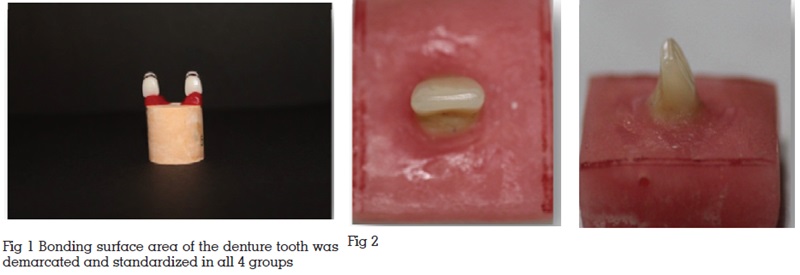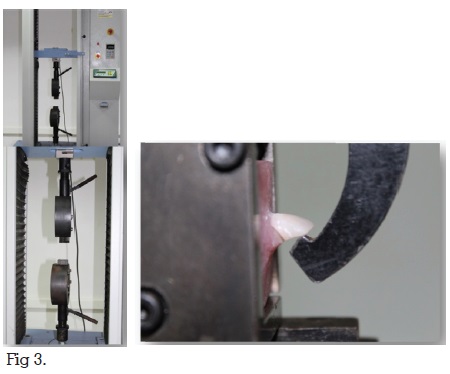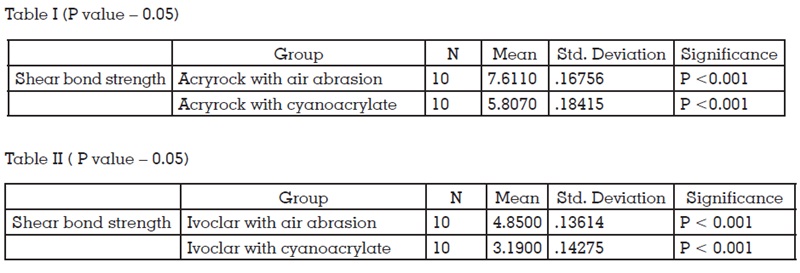

Statement of problem: De-bonding of denture teeth is the most common failure encountered in removable prosthodontics.
Purpose of the study: The purpose of the study is to improve the bond strength of denture teeth to denture base resin.
Aim of the study: To evaluate the effect of different surface treatments on the bond strength of two brands of denture teeth to PMMA.
Methodology: Two commercially available acrylic teeth has been used – Acryrock, Ivoclar. The bonding surface of the acrylic teeth to the denture base resin (meliodent heat cure PMMA) has been modified by means of surface treatment. The surface treatment indulged in this study are air particle abrasion (50 μm aluminium oxide) and cyanoacrylate application. Group 1 – Acryrock with air abrasion. Group 2 – Acryrock with cyanoacrylate. Group 3 – Ivoclar with air abrasion. Group 4 – ivoclar with cyanoacrylate. 10 specimens were made under each group. Bond strength of the specimen was tested in universal testing machine (Instron).
Results: Mean bond strength of Acryrock teeth treated with air abrasion was 7.6110 N/mm2 and that of Ivoclar teeth is 4.8500 N/mm2. Mean bond strength of Acryrock teeth treated with cyanoacrylate is 5.8070 N/mm2 and that of ivoclar teeth is 3.1900 N/mm2 and were statistically analysed by independent t test.
Conclusion: Acryrock treated with air abrasion showed higher bond strength compared to other groups
Denture teeth play a significant role in removable prosthodontics involving both esthetic and functional factors of a prosthesis. Its ability to withstand heavy occlusal loads without debonding especially in implant and tooth supported over dentures is pertinent for long term success of the prosthesis. Bond strength of denture tooth to the denture base material is the detrimental factor deciding this.1
To resolve the bonding failure,many authors have introduced various methods to improve the bond strength of denture teeth to the denture base. Mechanical modifications of the bonding surface of denture teeth such as grinding the ridge lap portions optimized the bonding in some instances.1,2 Diatorics placed in the denture teeth showed mixed results,depending on the type of denture base resins.1,3 Treating the surface of denture teeth with monomer of denture resin either compromised or had no effect on the bond strength of heat cured denture base resins.1,4
Chemical solutions such as dichloromethane or trichloromethane(chloroform) have been used along with monomer,with the anticipation that the solvent would enhance the monomer diffusion and polymer network formation.5
The aim of this study is to evaluate the effect of different surface treatments on the bond strength of two commercially available acrylic denture teeth to conventional heat cure denture base resins (PMMA). The null hypothesis is that these surface modifications will have no effect on the bond strength between the denture teeth and PMMA.
Two commercial denture teeth, (Acryrock, Ruthenium dental products, Italyand Ivostar, ivoclar, vivadent,Germany) were tested against a heat cure PMMA denture base resin (Meliodent, Heraeus, Kulzer). The surface treatments done were:
The specimens were grouped in to four groups with 10 specimens each as follows:
Group 1- Acryrock teeth treated with air abrasion
Group 2- Acryrock teeth with cyanoacrylate
Group 3- ivoclar teeth treated with air abrasion
Group 4- ivoclar teeth with cyanoacrylate
The bonding surface area of the upper central incisor denture tooth was calculated as 30mm2 and with the help of a template this was kept a constant for all the 40 specimens.( fig 1).

An indelible demarcating line circumscribed the area for bonding with PMMA.
Specimens were embedded in to rectangular wax blocks of dimensions 25x25x10mm3, up to the demarcating line. They were then invested in denture flasks and following wax elimination the exposed surface of the denture teeth of each group was treated with the designated surface treatments.
Air borne particle abrasion was performed on the ridge lap surfaces of teeth with 50 micro meter aluminium oxide particles at 2 bar pressure for 15 seconds. A standardized distance of 10mm was set with the help of a special holder. Cyanoacrylate was applied as a single layer on the bonding surfaces by means of a microbrush by a single operator to avoid bias. Heat cure PMMA denture base resin was packed in the mold and processed using compression moulding technique.
Following curing all 40 specimens were finished and polished for the shear bond testing (fig2)
The specimens were tested under universal testing machine(instron) with a constant crosshead speed of 1mm/minute. The universal testing machine has two compartments that tests the bond strength of the specimen by pulling it apart. Specimen fixed to the custom made jig was held by the lower compartment in such a way that the long axis of the tooth paralleled the floor. The custom made metal hook which engaged the lingual fossa of the central incisor was held by the upper compartment fig(3). The specimens were subjected to forces until debonding or fracture happened. The maximum force value (Mpa) to produce fracture was noted for each specimen. The type of failure and the fracture pattern was evaluated in detail for each specimen. Data collected and tabulated and subjected to statistical analyses. Independent t test was done for the test of significance (p<0.05).
Specimen loaded in the universal testing machine.

Mean bond strength of Acryrock teeth treated with air abrasion was 7.6110 N/mm2 and that of Ivoclar teeth is 4.8500 N/mm2. Mean bond strength of Acryrock teeth treated with cyanoacrylate is 5.8070 N/mm2 and that of ivoclar teeth is 3.1900 N/mm2. Independent t test was performed to analyse the significant difference in the groups, considering surface treatment and the denture teeth separately. Acryrock with airabrasion showed the highest bond strength. (mean bond strength – 7.611 N/ mm2). The mean shear bond strength values of all specimens were presented in Table I & II.
There are several techniques for reattachment of debonded acrylic tooth from denture base. This involves modification of the denture surface of the tooth to application of adhesives for the same. Evidence shows contradicting results regarding the modification of ridge lap area. Can and kanson6 proposed that modification of ridge lap area of denture teeth with retention grooves produced a stronger bond, whereas Huggett et al3 & Cardash et al7 found that the modification of the ridge lap area by grinding or by making grooves did not alter the bond strength of denture tooth to the denture base. In the present study, the ridge lap area has been modified with airborne particle abrasion and cyanoacrylate application.
Airborne particle abrasion ( 50 μm aluminium oxide ) improved the bond strength of both types of denture teeth in our study, in accordance to previous studies8,9. Chung et al10 reported that airborne particle abrasion produced several irregularities and undercuts on the bond surface in scanning electron microscope in spite of the increased surface area. Failure load of acrylic teeth treated with air abrasion (270 N) in our study is higher opposed to untreated acrylic resin teeth (140 N) as reported by Takashi et al.12 Mean shear bond strength of Acryrock teeth treated with air abrasion is 7.6110 N/mm2 (Table I) and that of ivoclar teeth is 4.8500N/mm2 (Table II).

Many chemicals have been tried to improve the adhesion in the previous studies. Dichloromethane application on the ridge lap area accentuated the bonding of acrylic resin teeth to denture base resin.5,11,12 More often than not, monomer was applied, before packing the resin, to improve the bond strength. Studies have shown promising results regarding monomer application.13,14
In the present study, Cyanoacrylate have been chosen as an adhesive agent. Cyanoacrylate was chosen because it was most commonly used in clinical situations, to repair the fractured denture and debonded tooth. The mean shear bond strength of Acryrock teeth treated with cyanoacrylate is 5.8070 N/mm2 and that of ivoclar teeth is 3.1900 N/mm2. Study reveals that the cyanoacrylate application reduced the bond strength of the acrylic denture teeth. The reason behind the reduced bond strength might be because of cyanoacrylate layer that prevented the diffusion of MMA from the denture base resin into the denture teeth.
Within the limitations of the study, it can be concluded that,